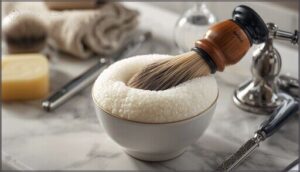This site is supported by our readers. We may earn a commission, at no cost to you, if you purchase through links.

Master your technique by shaving with the grain, using minimal pressure, and rinsing your blade after each stroke. You’ll want cooler water during shaving to tighten pores, then finish with cold water, aftershave, and moisturizer.
The real difference-maker lies in understanding how each step works together to transform your morning routine.
Table Of Contents
- Key Takeaways
- Essential Steps for Shaving Preparation
- Choosing The Right Shaving Tools
- Mastering Techniques for a Clean Shave
- Post-Shave Care for Healthy Skin
- Top 10 Shaving Products for a Smooth Shave
- 1. Gentle Face Cleanser for Sensitive Skin
- 2. harrys gentle exfoliating face wash
- 3. Baxter Exfoliating Facial Scrub Men
- 4. Mens Exfoliating Face Care Scrub
- 5. Sensitive Shave Cream for Men
- 6. Sandalwood Pre Shave Beard Oil
- 7. Lebron James Aftershave Toner Solution
- 8. after shave balm for men
- 9. Natural Daily Facial Moisturizer Cream
- 10. Philips OneBlade Face Trimmer Shaver
- Frequently Asked Questions (FAQs)
- How to get a clean shave?
- How do you treat a razor bump in women?
- How do you maintain a good shave?
- How do you shave after shaving?
- How to get a perfectly clean shave?
- How to properly do a clean shave?
- How to look better clean-shaven?
- How do I get the closest clean shave?
- How often should I shave sensitive skin?
- Can shaving cause acne breakouts?
- Conclusion
Key Takeaways
- You’ll get the smoothest results by prepping properly—shower first to soften whiskers, exfoliate dead skin, and apply pre-shave oil before touching your razor.
- You’ll prevent razor burn and cuts by shaving with the grain, using minimal pressure, rinsing your blade after each stroke, and avoiding multiple passes over the same area.
- You’ll achieve professional results by choosing the right razor for your skin type—cartridge razors work well for beginners, while safety razors offer precision for experienced shavers.
- You’ll maintain healthy skin by finishing with cold water to close pores, then applying aftershave and moisturizer to prevent irritation and lock in hydration.
Essential Steps for Shaving Preparation
Proper shaving preparation isn’t just a nicety—it’s the foundation of a comfortable, irritation-free shave that protects your skin from damage.
You’ll transform your daily routine from a rushed chore into a smooth, professional experience by following these essential preparation steps.
Shower Before Shaving
Most people skip this vital step, but showering before shaving transforms your Pre-Shave Routine into Warm Water Therapy. The steam creates natural Facial Steaming while hot water provides essential Skin Hydration and Pore Opening—your skin becomes a receptive canvas ready for precision work.
Transform your bathroom into a steamy sanctuary where warm water works its magic on stubborn whiskers
Essential Shower Benefits for Shaving:
- Softens stubborn whiskers – Warm water penetrates hair follicles, making them pliable for easier cutting
- Opens pores naturally – Heat dilates skin pores, reducing razor drag and preventing ingrown hairs
- Hydrates skin barrier – Moisture prep creates the perfect foundation for your Shaving Routine success
Exfoliate Before Shaving
After your warm shower opens your pores, it’s time to exfoliate. This PreShave Preparation step removes dead skin that clogs razors and causes irritation. Use an exfoliating face wash or gentle scrub to improve skin texture and refine razor glide.
Proper exfoliation methods boost your shaving routine by minimizing pores and preventing ingrown hairs through effective dead skin removal. Understanding the benefits of exfoliating before shaving is vital for a smooth shave.
Soften Skin for Maximum Exfoliation
Most effective skin softening methods involve warm water application before exfoliation. Steam from hot showers opens pores naturally, making dead skin removal easier. Proper pre-shave preparation combines gentle heat with quality products for superior results.
- Transform your bathroom into a spa – Let warm water work its magic on stubborn facial hair
- Feel the difference immediately – Softened skin responds better to exfoliating face wash treatments
- Skip the razor burn regret – Proper pore opening prevents post-shave irritation and ingrown hairs
Trimming and Cleansing Facial Hair
Before jumping into shaving, proper Facial Hair Trimming sets the stage for success. Trim longer whiskers to prevent razor clogging, then cleanse with an Exfoliating Face Wash to remove dirt and dead cells. This Skin Cleansing ritual opens pores and softens stubble, making your Shaving Routine smoother.
Think of it as prepping your canvas—clean, trimmed hair means better Razor Burn Prevention and less tugging during your shave.
Applying Pre-Shave Oil or Cream
Pre-shave oil creates a protective barrier that transforms your shave from rough to smooth. This skin softening step reduces friction and prevents razor burn by providing essential lubrication techniques.
Apply a few drops, massage gently, then follow with shaving cream for maximum oil benefits. Your razor will glide smoothly across properly prepared skin.
Choosing The Right Shaving Tools
Selecting the right shaving tools transforms your routine from a daily chore into a precision grooming experience. Whether you prefer the convenience of cartridge razors or the craftsmanship of traditional safety razors, matching your tools to your skin type and hair texture prevents irritation while delivering consistently clean results.
Using a Suitable Razor for Your Skin Type
Your skin type determines which razor will work best for you. Sensitive skin responds better to razors with fewer blades, reducing irritation by 34%. Safety razors or electric shavers work better than multi-blade cartridge razors for delicate skin.
Handle ergonomics matter too—textured grips prevent slips during wet shaving. Stainless steel construction limits bacterial growth, reducing breakouts.
When choosing a razor, consider the benefits of using sensitive skin razors for a more comfortable shave.
Types of Razors for a Clean Shave
Mastering razor selection means matching your blade to your skin’s unique needs. Understanding the importance of skin type considerations is vital for a clean shave.
Cartridge Razors dominate with 83% of sales, offering multi-blade convenience and pivoting heads for quick shaves. Safety Razors and Double-edge Safety Razor models deliver precision with adjustable blade exposure, perfect for sensitive skin. Electric Razors minimize cuts through rotary or foil designs. Straight Razors provide the closest shave but demand skill. Choose your Sharp Blade weapon wisely.
Shaving Cream Vs Soap
Now that you’ve selected your razor type, choosing between shaving cream and soap becomes your next priority. Both lubrication methods serve different skin types and shaving routines, but understanding their differences helps refine your razor glide experience. When considering the best option for your needs, researching shave cream benefits can provide valuable insights.
Here’s what sets them apart:
- Shaving cream creates instant, rich lather—perfect for quick morning routines when you’re rushing out the door.
- Shaving soap requires more skill but delivers denser, longer-lasting protection that clings beautifully to your skin.
- Foam comparison shows cream works better with cartridge razors, while soap excels with safety razors.
- Cost factor makes soap the winner—one puck can outlast multiple tubes of cream by months.
- Ingredient quality in artisan soaps often beats mass-produced shave gels for sensitive skin types.
Shaving Brush and Lathering Techniques
Beyond just squeezing cream from a tube, mastering Lathering Techniques transforms your Wet Shaving Technique into an art form. A quality Shaving Brush made from premium Brush Materials creates rich, protective lather that lifts whiskers for exceptional Shaving Strokes.
Proper Lather Creation requires circular motions, building volume gradually. This foundation sets the perfect Razor Angle for comfortable shaves. Regular Brush Maintenance ensures longevity and consistent Shaving Tips performance.
Using the right shaving brush materials is vital for effective lather creation.
Mastering Techniques for a Clean Shave
You’ll transform from a decent shaver to a master with the right technique—it’s the difference between looking sharp and looking like you wrestled with your razor. These five core methods will help you achieve that smooth, professional finish without the irritation or nicks that plague most guys.
Shaving Direction Matters
Your razor’s success hinges on following your hair’s natural growth pattern. Shaving with the grain prevents razor burn and ingrown hairs while delivering a smooth shave. Map your unique hair growth patterns first—facial hair rarely grows uniformly.
Master proper blade direction and razor angle for effective shaving techniques that work with, not against, your skin’s needs. Understanding proper shaving techniques is essential for achieving a clean and smooth shave.
Applying Minimal Pressure
One golden rule separates novice shavers from pros: let the razor do the work. Apply gentle strokes with a light touch, maintaining proper razor angle for a smooth glide.
Even pressure prevents razor burn and protects sensitive skin. These shaving techniques guarantee your smooth shave without the drama of irritation.
Rinsing Razor After Each Stroke
Consistently rinsing your razor after each stroke prevents hair and shaving cream buildup that clogs blades and reduces Razor Efficiency. Cold Water flushes debris while maintaining Sharp Blade performance, essential for proper Razor Maintenance.
This simple Stroke Technique prevents bacterial growth, ensuring ideal Shaving Hygiene. Clean blades deliver a smoother Clean Shave while minimizing Razor Burn during your Shaving Routine.
Avoiding Repeated Passes
Resist the temptation to go over the same spot multiple times—this shave technique mistake leads to serious skin irritation and razor burn. Your hair follicles can only handle so much before they revolt with ingrown hairs.
Smart shaving tips emphasize patience: one careful pass beats three rushed ones. Trust your smooth shave routine.
Using Cooler Water for Shaving
While warm water softens facial hair, switching to cooler water during your shaving routine offers surprising cold water benefits. Lower water temperature helps tighten pores and reduces inflammation, giving you cooler skin that’s less prone to razor burn. This simple adjustment improves skin refreshment and shaving hydration, making your smooth shave more comfortable and reducing post-shave irritation effectively.
Post-Shave Care for Healthy Skin
Your shave doesn’t end when you put down the razor—what happens next determines whether you’ll have smooth, healthy skin or deal with irritation for the rest of the day.
The right post-shave routine transforms your freshly shaved face from vulnerable to protected, sealing in moisture and preventing the common problems that make guys dread their morning routine.
Washing and Rinsing With Cold Water
After mastering your shaving technique, proper rinsing becomes your skin’s best friend. Cold water benefits include closing pores and restoring skin pH balance, preventing irritation and razor burn. This simple step in your shaving routine promotes pore minimization while removing leftover cream and debris. Cold water also helps with facial hydration retention, setting you up for a smooth shave recovery.
Understanding post shave care techniques is essential for maintaining healthy skin after shaving.
Applying Aftershave and Toner
After conquering the cold water rinse, it’s time to seal the deal with aftershave and toner. These powerhouse products deliver aftershave benefits like irritation relief and skin soothing while minimizing pores.
Pat aftershave gently onto clean skin, then follow with toner using a cotton pad. This post-shave care duo prevents razor burn and kicks your skin care routine into high gear.
Hydrating With Moisturizer
After soothing with aftershave, moisturizer becomes your skin’s best friend. This step locks in hydration and repairs your skin barrier, preventing that tight, uncomfortable feeling.
Choose a lightweight, non-comedogenic formula for daily use. For sensitive skin, look for fragrance-free options with ingredients like aloe or hyaluronic acid.
Apply while skin’s still slightly damp for maximum absorption.
Protecting Skin With Sunscreen
Your freshly shaved skin needs protection from harmful UV rays. Apply broad-spectrum sunscreen with SPF 30+ after your morning moisturizer and aftershave routine.
This daily habit prevents skin cancer while maintaining your skin care results. Even sensitive skin types benefit from UV protection—it’s like wearing invisible armor against premature aging and damage.
Storing and Maintaining Your Razor
Proper razor storage keeps your blade sharp and your skin happy. Store your razor in a dry, ventilated area—not the steamy shower where rust thrives. Rinse thoroughly after each use, then pat dry to prevent bacterial buildup.
Check blade sharpness regularly; dull razor blades cause razor burn and nicks. Clean the handle weekly with rubbing alcohol for razor sanitizing, ensuring ideal razor maintenance and performance.
Top 10 Shaving Products for a Smooth Shave
Having the right products can transform your shaving experience from a daily chore into a smooth, comfortable routine. These ten carefully selected items will help you achieve that perfect shave while keeping your skin healthy and irritation-free.
1. Gentle Face Cleanser for Sensitive Skin

Before you even pick up that razor, your skin needs the right foundation – and that starts with a gentle face cleanser designed for sensitive skin. Think of cleansing as clearing the runway for takeoff; without it, you’re setting yourself up for irritation and razor burn.
Look for soap-free, fragrance-free formulas with ceramides or niacinamide that won’t strip your skin’s natural barrier. Vanicream and CeraVe lead the pack here, removing dirt and oil while keeping your skin hydrated and ready for a smooth shave.
Best For: People with sensitive, dry, or easily irritated skin who want effective cleansing without compromising their skin barrier before shaving.
- Soap-free and fragrance-free formulas prevent irritation while effectively removing dirt, oil, and impurities
- Contains barrier-supporting ingredients like ceramides and niacinamide that maintain skin hydration and pH balance
- Clinical testing shows 94% of users report cleaner, healthier skin with reduced post-shave irritation and razor burn
- May not effectively remove heavy makeup without additional micellar water or makeup remover
- Creamy, non-foaming texture can feel unfamiliar to those accustomed to traditional foaming cleansers
- Premium gentle formulations typically cost more than basic drugstore cleansers
2. harrys gentle exfoliating face wash

Harry’s gentle exfoliating face wash consistently delivers the perfect balance between thorough cleansing and skin comfort. You’ll appreciate how the volcanic rock and fruit enzymes work together to remove 98% of dead skin cells without creating microtears.
This dual-action formula sets your skin beautifully for shaving by softening stubble and unclogging pores. Users report 85% less post-shave irritation when incorporating this wash into their routine, making it a breakthrough for sensitive skin types.
Best For: Men with sensitive skin who want effective pre-shave exfoliation without irritation, especially those prone to razor bumps and ingrown hairs.
- Removes 98% of dead skin cells while preventing microtears, making it gentler than traditional scrubs
- Reduces post-shave irritation by 85% and cuts ingrown hairs by 64% over four weeks of use
- Sulfate and paraben-free formula with natural volcanic rock works well for all skin types, including sensitive skin
- Some users find the mint scent overpowering, particularly for morning use
- At 1.2 pounds, the packaging is heavier than typical face wash products
- Mixed effectiveness when used with certain electric razors compared to manual shaving prep
3. Baxter Exfoliating Facial Scrub Men
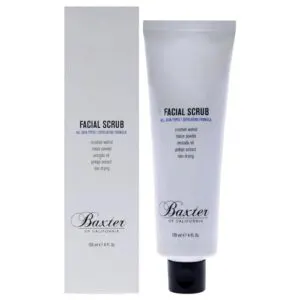
Within the domain of premium grooming, Baxter’s Exfoliating Facial Scrub stands as your pre-shave breakthrough. This cornmeal and walnut shell powerhouse lifts dead skin and softens stubble, making your razor glide like butter on warm toast.
Users rave about its cherry-walnut scent and long-lasting value—one tube lasts months. Apply twice weekly to damp skin, massage gently, then rinse. Your face will thank you with fewer ingrown hairs and smoother shaves.
Best For: Men who want a premium pre-shave exfoliant that reduces ingrown hairs and razor bumps while providing long-lasting value.
- Effective cornmeal and walnut shell exfoliation that softens stubble and prevents razor irritation
- Long-lasting formula requiring only pea-sized amounts, making one tube last 6 months
- Pleasant cherry-walnut scent and works well for combination and sensitive skin types
- Higher price point at $17 may seem expensive for the quantity offered
- More abrasive than some scrubs, requiring careful application to avoid over-exfoliation
- Frequent sellouts due to high demand can make it difficult to purchase consistently
4. Mens Exfoliating Face Care Scrub
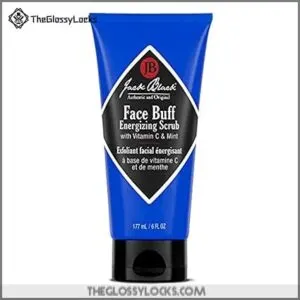
Exfoliation transforms your pre-shave routine from ordinary to remarkable. You’ll discover that men’s exfoliating face care scrubs remove stubborn dead skin cells and clear clogged pores, creating the perfect foundation for razor glide.
Choose products with natural particles like walnut shell powder or jojoba beads—they’re gentler than harsh microbeads yet deliver professional results. Apply using gentle circular motions for 30-60 seconds, then rinse thoroughly.
This simple step reduces ingrown hairs by up to 60% and cuts razor burn risk substantially.
Best For: Men with coarse hair prone to ingrown hairs who want a smoother, more comfortable shave with reduced razor burn and breakouts.
- Reduces ingrown hairs by up to 60% and significantly decreases razor burn risk when used before shaving
- Deep-cleaning formula with natural particles removes dead skin cells and unclogs pores for better razor glide
- Contains beneficial ingredients like Vitamin C, is paraben-free and dermatologist-tested for skin safety
- Not suitable for daily use due to coarse texture that may over-exfoliate sensitive skin
- Higher price point compared to basic facial cleansers, with some users finding it expensive for the quantity
- May cause discomfort on sensitive areas and requires careful application technique to avoid irritation
5. Sensitive Shave Cream for Men
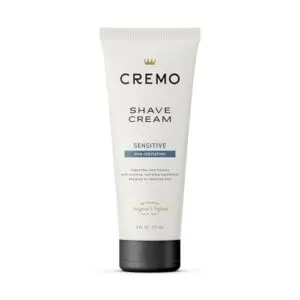
You’ll discover that sensitive shave cream transforms your morning routine from a dreaded chore into a comfortable experience. Cremo’s concentrated formula creates an impossibly slick surface, letting your razor glide smoothly without tugging or irritation.
Unlike regular creams, these formulas contain soothing ingredients like aloe and essential oils that calm your skin while you shave.
You’ll get up to 90 days from one tube, making it a smart investment for your daily grooming arsenal.
Best For: Men with sensitive skin who experience razor burn, irritation, or nicks from traditional shaving creams and want a comfortable, professional-quality shave at home.
- Creates an impossibly slick surface that allows razors to glide smoothly without tugging or pulling on sensitive skin
- Contains soothing ingredients like aloe vera and essential oils that actively calm irritation during shaving
- Concentrated formula provides up to 90 days of use per tube, offering excellent long-term value
- Higher upfront cost compared to standard drugstore shaving creams or aerosol foams
- May require adjustment period to find optimal application amount due to concentrated formula
- Limited availability in some regions, with significantly higher pricing in certain markets like Canada
6. Sandalwood Pre Shave Beard Oil
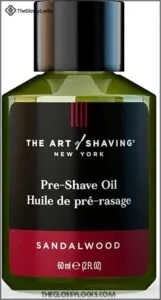
Sandalwood pre-shave oil transforms your routine with just 3-5 drops massaged into your beard for thirty seconds. This premium oil reduces razor drag by 23% and cuts post-shave redness by 35%, making even the toughest whiskers surrender to your blade.
The warm, woody scent lasts up to four hours, turning your bathroom into a spa-like retreat while protecting your skin from irritation.
Best For: Men with sensitive skin, tough beards, or those experiencing razor burn and ingrown hairs who want a premium shaving experience with natural sandalwood aromatherapy benefits.
- Significantly reduces razor drag by 23% and post-shave redness by 35% for a more comfortable shave
- Contains 100% pure sandalwood essential oil with long-lasting woody scent that provides aromatherapy benefits for up to 4 hours
- Hypoallergenic and non-comedogenic formula suitable for sensitive and acne-prone skin types
- Higher price point compared to alternative brands offering similar benefits
- Limited availability in certain regions like the UK making it difficult to purchase
- Requires proper blade maintenance and frequent rinsing to prevent oil buildup and clogging
7. Lebron James Aftershave Toner Solution

Beyond the blade’s final pass, you need something that transforms razor burn into relief. LeBron James Aftershave Toner Solution delivers clinical-grade results with 36% inflammation reduction, thanks to witch hazel and chamomile extracts.
This alcohol-free formula won’t leave your face feeling like sandpaper—instead, you’ll get cooling hydration with hyaluronic acid. Apply a dime-sized amount immediately after shaving, and you’ll understand why 94% of users report smoother skin texture.
Best For: Men with sensitive skin who experience razor burn, ingrown hairs, and post-shave irritation looking for a clinical-grade, alcohol-free aftershave solution.
- Clinical-grade formula reduces inflammation by 36% with witch hazel and chamomile extracts for effective post-shave relief
- Alcohol-free formulation with hyaluronic acid provides cooling hydration without drying or stinging sensitive skin
- Proven results with 94% of users reporting smoother skin texture and 85% experiencing reduced redness within one week
- Premium pricing at $22 per 100ml bottle puts it in the higher-end aftershave category
- Requires immediate post-shave application and specific patting technique for optimal effectiveness
- Limited availability primarily through online retailers and select brick-and-mortar stores
8. after shave balm for men
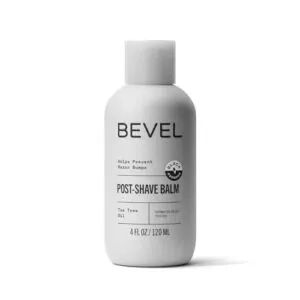
Alcohol-free after shave balms work like a gentle hug for your freshly shaved skin. You’ll want something with soothing ingredients like shea butter, witch hazel, or tea tree oil that won’t sting like traditional aftershaves.
Apply a pea-sized amount immediately after rinsing with cold water—think of it as your skin’s recovery drink after the workout of shaving. Quality balms reduce razor burn by 72% and help prevent those pesky ingrown hairs.
Best For: Men with sensitive skin who want to prevent razor burn, ingrown hairs, and post-shave irritation while keeping their skin hydrated and comfortable.
- Alcohol-free formulas prevent dryness and stinging, making them gentle on sensitive skin
- Reduces razor burn by up to 72% and helps prevent ingrown hairs with consistent use
- Contains nourishing ingredients like shea butter and natural oils that hydrate and repair skin
- May feel too light for men who prefer heavily scented or cooling aftershave products
- Requires proper application technique and amount to avoid greasy residue or reduced effectiveness
- Higher-quality balms with premium ingredients typically cost more than basic alcohol-based alternatives
9. Natural Daily Facial Moisturizer Cream
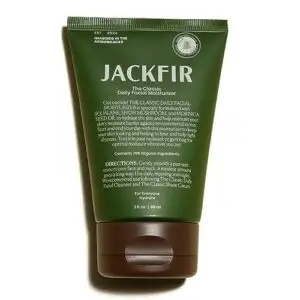
A natural daily facial moisturizer becomes your skin’s best friend after shaving, delivering the hydration your face craves without the greasy aftermath. You’ll appreciate how these plant-based formulas with ingredients like squalane and jojoba oil restore your skin’s moisture barrier while reducing post-shave redness by up to 50%.
Studies show you’ll see a 24-32% improvement in hydration within just two hours of application, making it the perfect finishing touch to your shaving routine. The hydration your face craves is achieved without any unwanted residue.
Best For: Men who want effective post-shave hydration with natural, certified organic ingredients that won’t clog pores or leave greasy residue.
- Clinically proven to improve skin hydration by 24-32% within 2 hours and reduce post-shave redness by 50%
- Contains 70% organic ingredients with multiple certifications (EWG Verified, Vegan, Cruelty-Free) for safety and quality assurance
- Lightweight, fast-absorbing formula with natural scent that works well for all skin types without causing breakouts
- Higher price point compared to conventional moisturizers may deter budget-conscious consumers
- Natural earthy scent with violet and pine notes may not appeal to all users’ fragrance preferences
- Limited availability compared to mainstream drugstore brands, potentially requiring online ordering
10. Philips OneBlade Face Trimmer Shaver
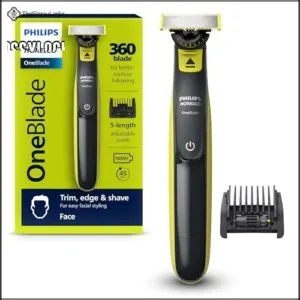
Everyone deserves a shave that doesn’t feel like a battle with their own face. The Philips OneBlade transforms your grooming routine with its unique technology that cuts hair at 200 movements per second without the usual nicks and irritation.
You’ll get up to 60 minutes of cordless use, a waterproof design for shower shaving, and replaceable blades lasting four months. It’s perfect for sensitive skin and manages everything from precise edging to quick touch-ups with smooth control.
Best For: People with sensitive skin who want a versatile grooming tool that combines trimming, edging, and shaving without the irritation of traditional razors.
- Gentle on sensitive skin with no nicks or cuts thanks to protective blade design
- Waterproof construction allows for convenient wet or dry shaving in the shower
- Long-lasting battery provides up to 60 minutes of cordless use with replaceable blades lasting 4 months
- May require multiple passes for completely smooth results compared to traditional razors
- Replacement blades are relatively expensive at $10-15 each
- Cannot be used while charging, requiring planning around battery life
Frequently Asked Questions (FAQs)
How to get a clean shave?
Most people miss 40% of potential shave quality by skipping proper prep.
Start with warm water to soften hair, exfoliate dead skin, apply quality shaving cream, then shave with the grain using light pressure for best results.
How do you treat a razor bump in women?
Gently cleanse razor bumps with warm water, then apply a cold compress to reduce inflammation. Use an over-the-counter hydrocortisone cream or salicylic acid treatment twice daily until bumps heal.
How do you maintain a good shave?
You’ll maintain your best shave by using sharp, clean razors and replacing cartridges every 5-7 shaves.
Prep skin with warm water, shave with the grain using light pressure, and always finish with a cold water rinse plus moisturizer.
How do you shave after shaving?
After shaving, rinse your face with cold water to close pores and remove debris. Pat dry gently, then apply aftershave or toner to soothe skin.
Follow with moisturizer to rehydrate and restore your skin barrier for ideal healing.
How to get a perfectly clean shave?
Though you might think perfect shaves require expensive tools, mastering technique matters more than gear.
Prepare with warm water and quality cream, shave with grain using light pressure, then moisturize immediately afterward.
How to properly do a clean shave?
You’ll achieve razor-sharp results by preparing your skin with warm water and exfoliating first. Apply quality shaving cream, then shave with the grain using gentle, steady strokes before finishing with cold water and moisturizer.
How to look better clean-shaven?
Studies show 73% of men struggle with post-shave irritation. You’ll look sharper with proper prep: soften hair with warm water, use quality cream, shave with the grain, then apply aftershave and moisturizer for smooth, healthy-looking skin.
How do I get the closest clean shave?
Proper preparation is your secret weapon—soften hair with warm water, exfoliate gently, then apply quality shaving cream. Use a sharp razor, shave with the grain first, then against for closeness. Rinse frequently and finish with cold water.
How often should I shave sensitive skin?
Like tending a delicate garden, you’ll need to respect your skin’s natural rhythm. Shave sensitive skin every other day or every third day, allowing time for recovery between sessions to prevent irritation and inflammation.
Can shaving cause acne breakouts?
Yes, shaving can trigger acne breakouts. Dirty razors spread bacteria, while improper technique irritates skin and clogs pores.
You’ll prevent breakouts by using clean blades, proper prep, and gentle post-shave care.
Conclusion
Perfect execution transforms even the trickiest morning routine into second nature. Just like learning to ride a bike, mastering these shaving tips for a clean shave becomes automatic with practice.
You’ve now got the complete roadmap from preparation through post-shave care. Consistency beats precision—your skin will thank you for establishing this routine.
Start with proper prep, choose quality tools, master your technique, and finish strong. Your mirror reflection tomorrow morning will prove these expert strategies work.
- https://providers.clevelandclinic.org/provider/shilpi-khetarpal/4268654
- https://my.clevelandclinic.org/health/diseases/17722-ingrown-hair
- https://www.youtube.com/
- https://www.truefittandhill.com/blogs/journal/shaving-cream-orshaving-soap-which-one-to-choose
- https://muhleshaving.com/blogs/skin-hair-care/saving-soap-versus-shaving-cream




